Last week, we watched the Argentine film “Nueve Reinas” at home with our children. In this film, they tell the story of nine extraordinary stamps from the Weimar Republic. I was wondering, does Basque coinage have its own nine queens? Yes, sir, but in this case, we should name the nine kings!
The name of the Dutch engraver and engraver Jean Warin appears with fame and honor in the history of coinage. After acquiring ownership of the Monnaie du Moulin mint in Paris and thanks to the patronage of Cardinal Richelieu, Warin completely changed the coinage system of the French kingdom.
In the Kingdom of France in general and industrially flywheel press We owe its widespread use to him, after the prohibition of hammered coinage in the 1640s.
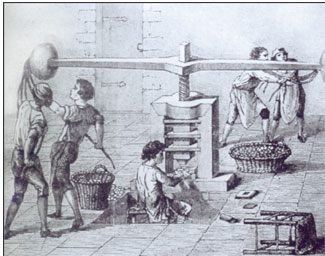
Image of a handwheel press from Diderot and d'Alembert's encyclopedia – Wikipedia
We also owe him some of the most beautiful and fascinating designs created by the French coin and medal iconography.
Jean was born in the present-day city of Liège, Belgium, in 1604. His father, already a coin engraver, moved to Paris in 1626. After acquiring ownership of the Monnaie de Moulin and the patronage of Richelieu, he was the author of various coin designs in the 1640s, until he became general engraver of French coins (graveur général des monnaies de France) in 1647.
From that year on, he was the creator of the coin images produced by the wheel press, which were spreading throughout the kingdom, and the maker of the punches used to produce them.
He first worked on medals and medals, images that were later depicted on coins. Here, a medal from 1645 depicting the infant King Louis and his mother Anne of Austria.
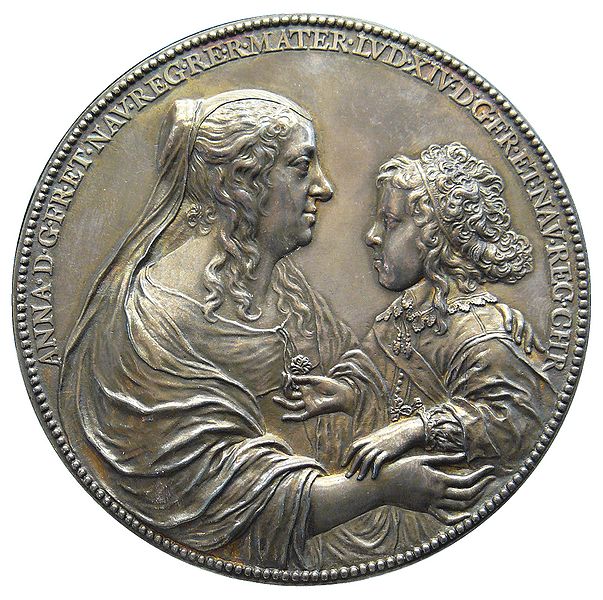
One of the medals created by the engraver Jean Warin – Queen Anne of Austria and King Louis XIV around 1645 – Silver, 70 mm
They were minted in 1652 at the Donapaleu mint. latest hammered specimens (only two copies from this year are known). In the same year, 1652, a new and powerful wheel press was put into operation and as a result, for the first time, the beautiful silver shields of King Louis III of Navarre appeared, bearing the image of the engraver Jean Warin.
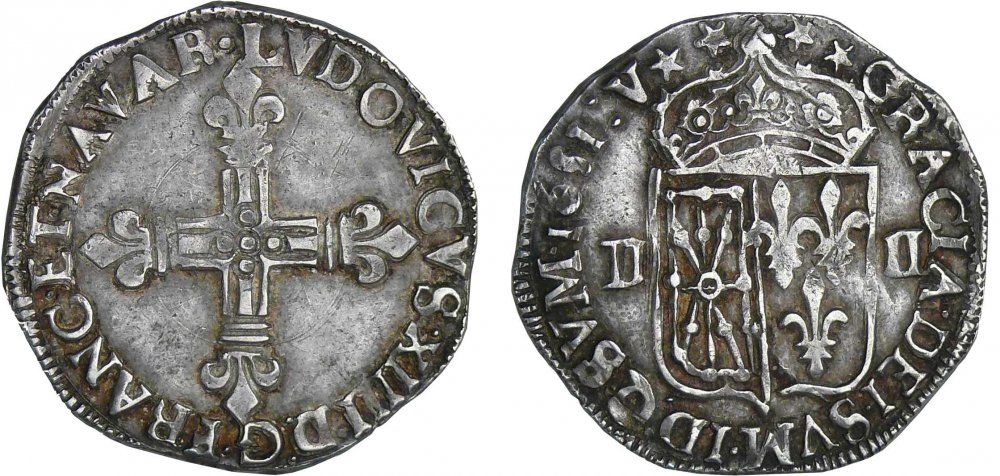
One of the last silver quarter coins struck by hammer in 1651 at the Donapaleu mint – 9.62 gr, 32 mm
Front: LVDOVICVS.XIIII.DGFRANC.ET.NAVA.R
Reverse: GRACIA.DEI.SVM.ID.Q.SVM.1651 V (V left Jean Verdoye mintmaster)
The mints of Bayonne, Donapaleu, Morlaas and Pau were among the last French mints to receive the flywheel presses. Bayonne and Pau began using the new machines in 1650, and Morlaas and Donapaleu in 1652.
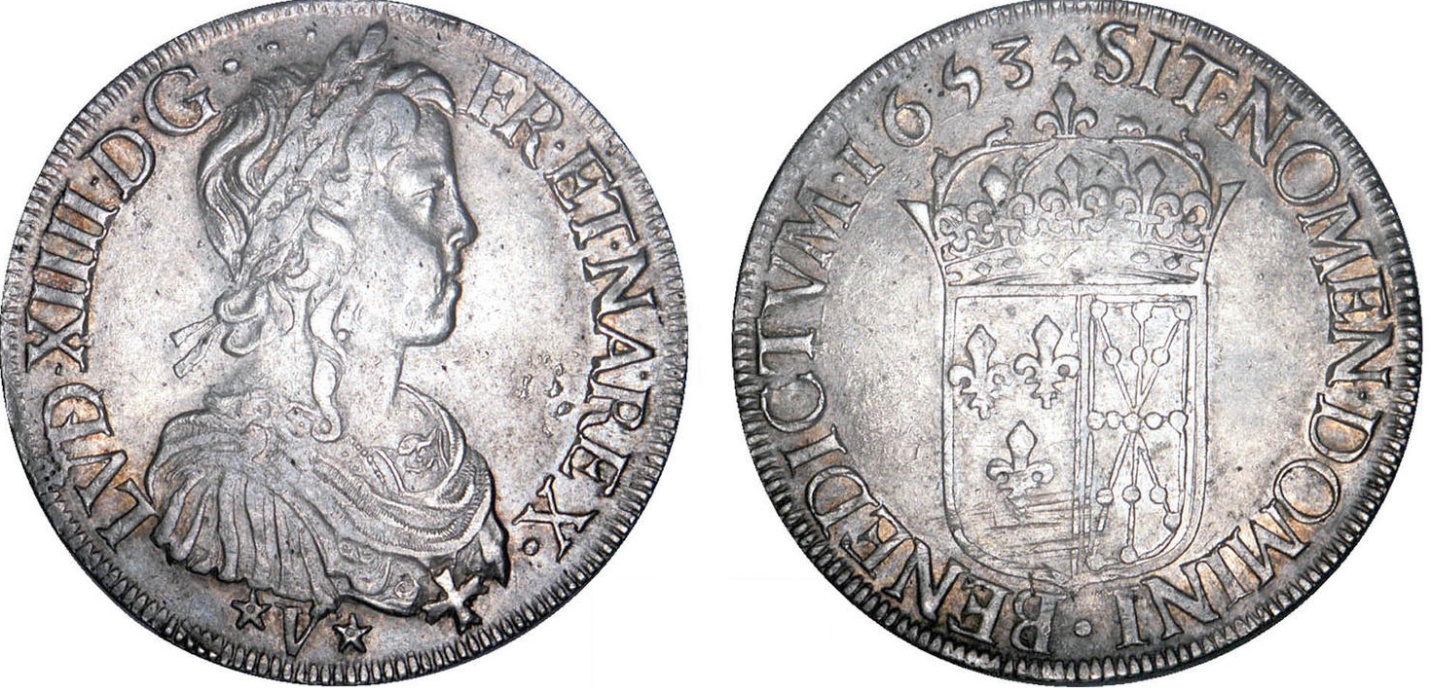
Silver shield of Donapaleut of King Louis XIV with the image of a long haired mane – Portrait of Jean Warin – 27.11gr 39.1mm
Obverse: LVD.XIIII.DGFR.ET.NA.REX V (V left Jean Verdoye mintmaster)
Back: SIT.NOMEN.DOMINI.BENEDICTVM.1653 (Heart – Engraver Simon d'Armagnac of Donapaleu)
Silver shields with the image of a long haired woman were minted at the Donapaleu mint for ten years. In addition to shields, their fractions, half shields, quarter shields and others were also minted, but the largest part of the production was devoted to the minting of these large and beautiful silver coins.
Suddenly in 1662, Denis Genisseau, the general manager of the French mints, ordered the closure of the mints of Pau, Morlaas and Donapaleu. The institutions of Bearn and Lower Navarre protested strongly, as these three mints were subordinate to the Chamber of Accounts of Navarre (Chambre des Comptes de Navarre) and not to the French Mint (Cours des Monnaies de France).
The events surrounding this closure deserve their own blog post and we will not discuss them today. We will only say that; in the same way that the Pau mint had been reopened eight months earlier, the Donapaleut mint was reopened at the end of 1663. However, the long history of the Morlaas mint was interrupted once and for all in that year 1662.
The coinage, which resumed in 1664, used the new royal image of Jean Warin. In this case, the coins minted between 1664 and 1671 used the so-called youthful bust or image. During the last nine years of the Donapaleu mint's life, only silver shields with a value of 3 livres (60 sous) were minted, no gold coins were minted. No silver fractional shields were minted during this last period.
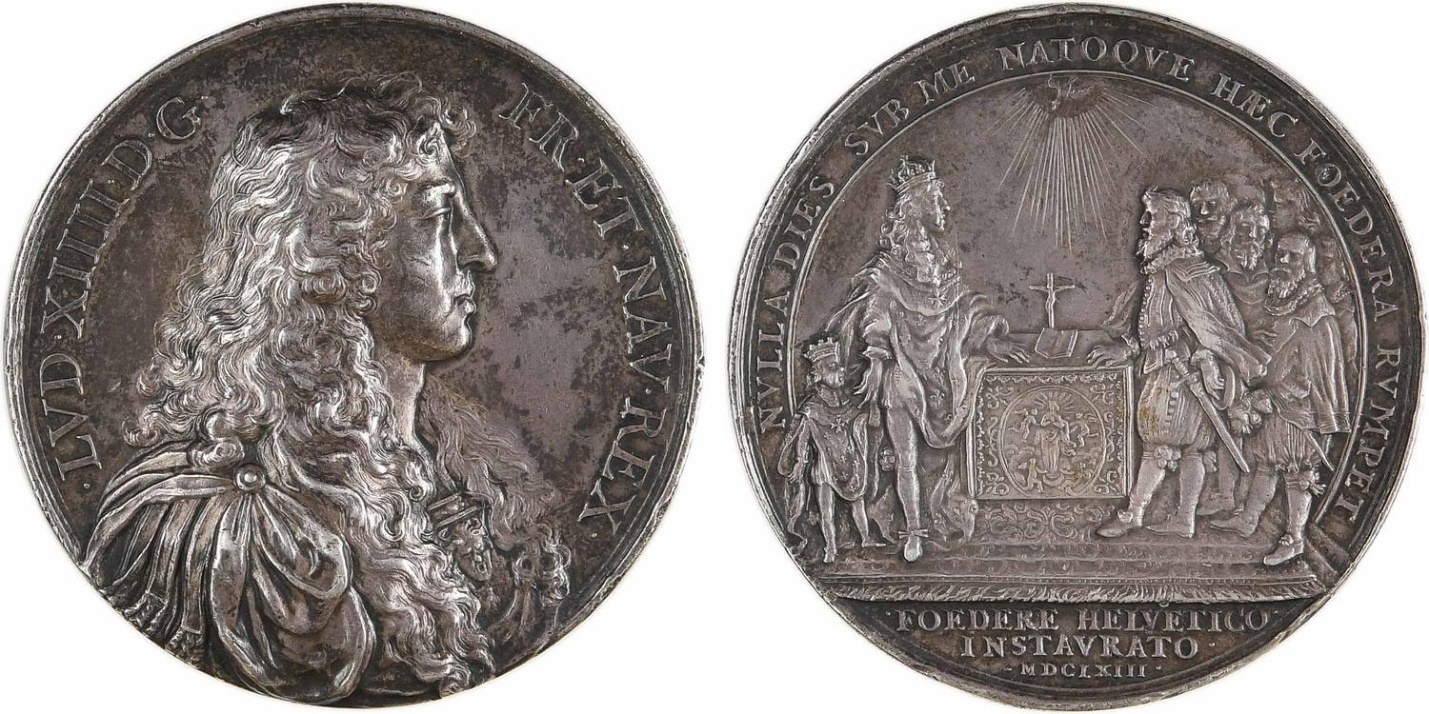
Medal with the image of King Louis XIV as a youth – Treaty with the Swiss peoples – Jean Warin, 1663 Paris
Silver 55.6 mm 83.92 gr 12 h
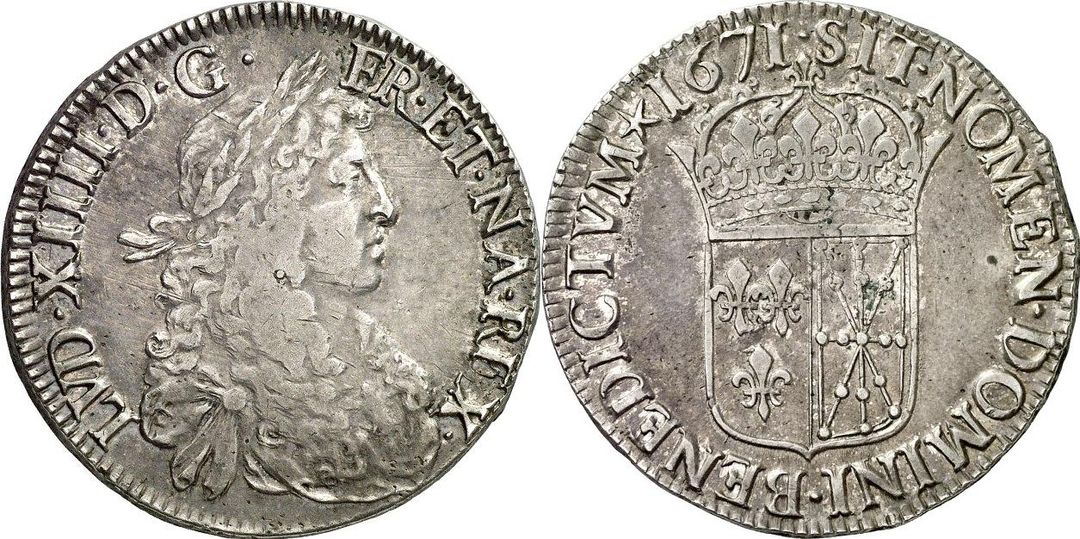
Silver shield of Donapaleu depicting the youthful image of King Louis XIV – portrait by Jean Warin –
Front: LVD.XIIII.DGFR.ET.NA.REX
Reverse: SIT.NOMEN.DOMINI.BENEDICTVM.1671 – Francois de Noir mintmaster (Star)
Jean Warin died at the end of August 1672. Before his death, he had carved the dies for the new royal image to appear on the 60-soueur silver shields for two mints, the Paris and Toulouse mints.
The new portrait was first used during the so-called “War of the Restoration”, specifically on medals made between 1667 and 1668. This new portrait broke with the images of Louis XIV with his long hair and youthful busts, which had been suggested in antiquity. In this case, the portrait fit well with the war against the Netherlands, which had just begun on April 6, 1672.
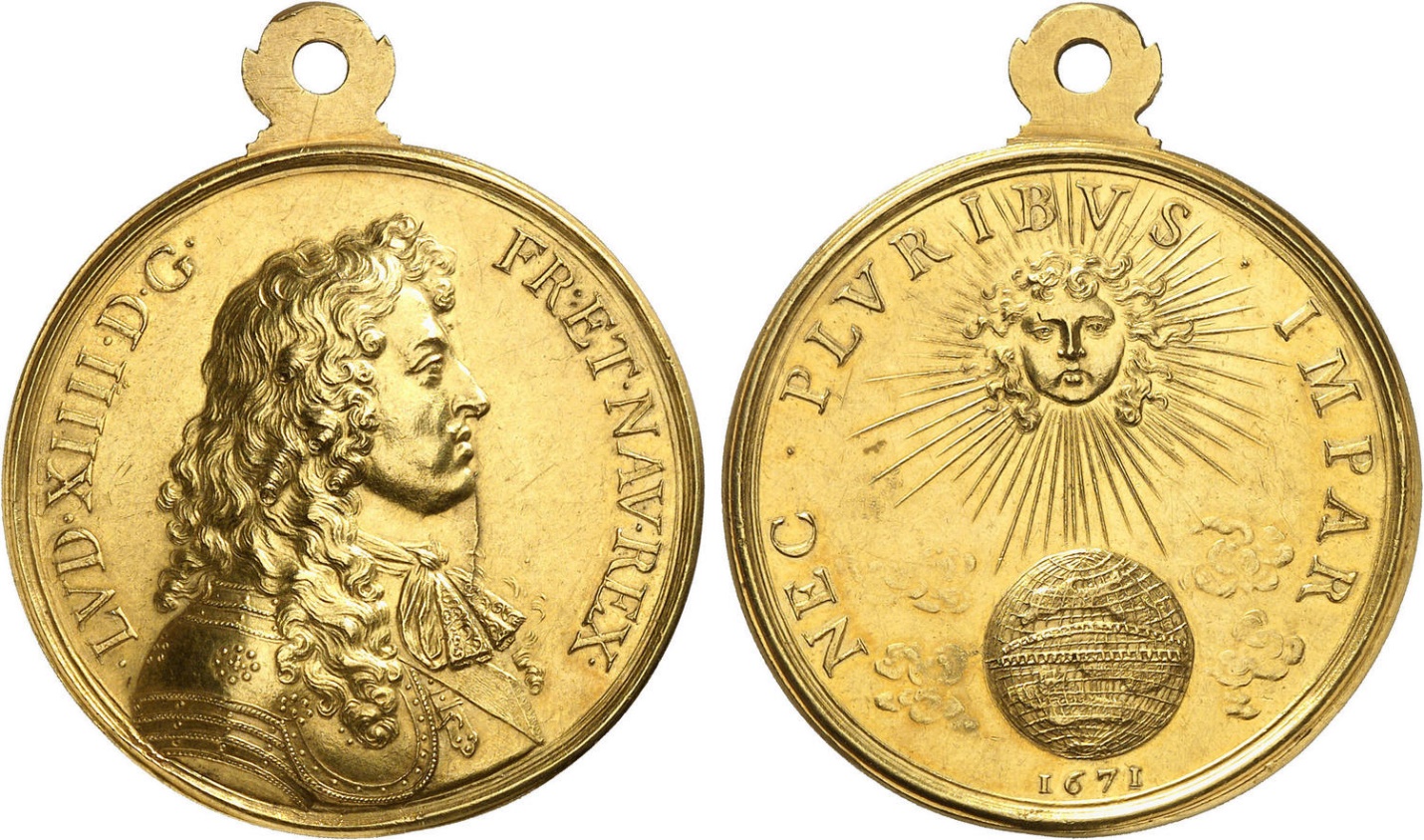
Gold medal from 1671 depicting the tie of King Louis XIV – Jean Warin.
50.00mm, 62.25 grs. – Sun King
NEC PLVRIBVS IMPAR – “Fit for several tasks at the same time”
The new portrait presented King Louis XIV in military uniform, wearing a breastplate, as a battlefield general, and a tie that hung from his neck. It was this tie that gave the image its name, the image of King Louis XIV with a tie.
A few days before his death, on 4 August 1672, Warin left a new royal stamp at the Court of Mint (Cour des Monnaies de France). This stamp was intended for the Toulouse mint, which had reopened six years earlier.
However, the Toulouse mint's flywheel press was not adapted to produce 27-gram silver shields. As a result, according to expert Christian Charlet, Claude Thomas, head of the French mints, and representatives of the Toulouse mint management, contacted the mintmaster of Donapaleu, Francois Le Noir.
The Donapaleu mint had a big problem on its hands at the time. At the end of 1671, an investigation into counterfeiting had confiscated all the punches and dies for the young king's image that it had for minting coins. It still had silver in its vaults, but not a single die for minting that silver.
As a result, it seems that the three parties decided to send the new punch to the Donapaleu mint. But on September 28, 1672, Claude Thomas lost his position as head of the French mints, and as a result, the Donapaleu mint was closed forever. The courts of Lower Navarre addressed requests for the reopening of the mint to the French Mint and King Louis in 1673, 1674, 1675, 1678, 1684 and 1687. All these requests went unanswered and in 1687, the Donapaleu wheel press and all the coinage tools were transported to the Bayonne mint. The three hundred years of coinage history ended once and for all and was a huge blow to the local economy, since such a mint employed at least a hundred workers.
Between the end of August and the beginning of October 1672, 29,651 shields were minted with the image of the king's tie, With a total weight of 3296 marks, one ounce and 21 pennies. Along with the coins struck in Paris, they were the only coins of 1672 to bear the royal tie. The royal tie was introduced to the mints of Bayonne and Rennes in 1673, Lyon in 1676, and finally became common in the rest of France in 1679.
No trace of the shields produced in 1672 by Warin's punches has been found at the Paris Mint. In the case of the Donapaleu Mint, of the 29,651 coins produced, 9 known specimens Only a few have survived to our days; these are the "nine queens" of our silver coinage. Apparently, all of the specimens are in private hands, meaning that museums or large public collections do not have any specimens in their displays or deposits.
And as is well known, due to the scarcity of these coins and the significance of this year's coins, collectors are throwing money at the parades when one of these coins appears at auctions. In recent years, six of these nine coins have been sold. I have followed the numbering given by Christian Charlet, which we will explain later. Here are the six coins that have appeared at auctions in recent years:
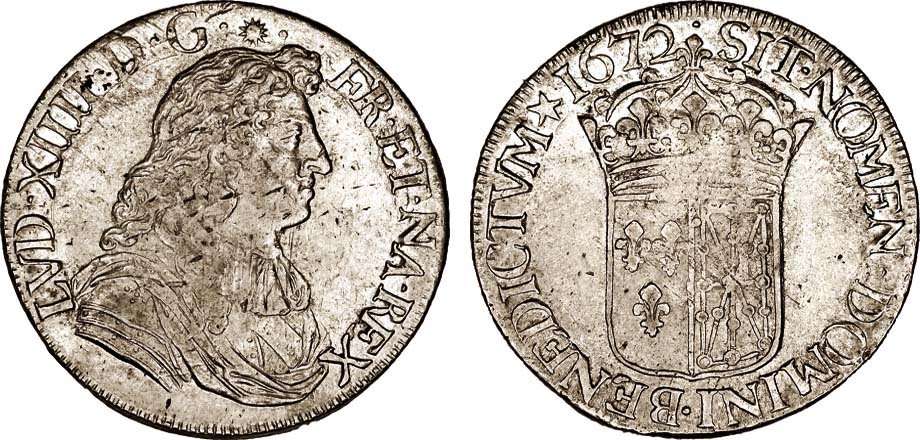
Shield sold by The Bru Sale on December 9, 2011 – 26.97gr, 6h – €18,000 – Blandine Collection – Described as 6th edition
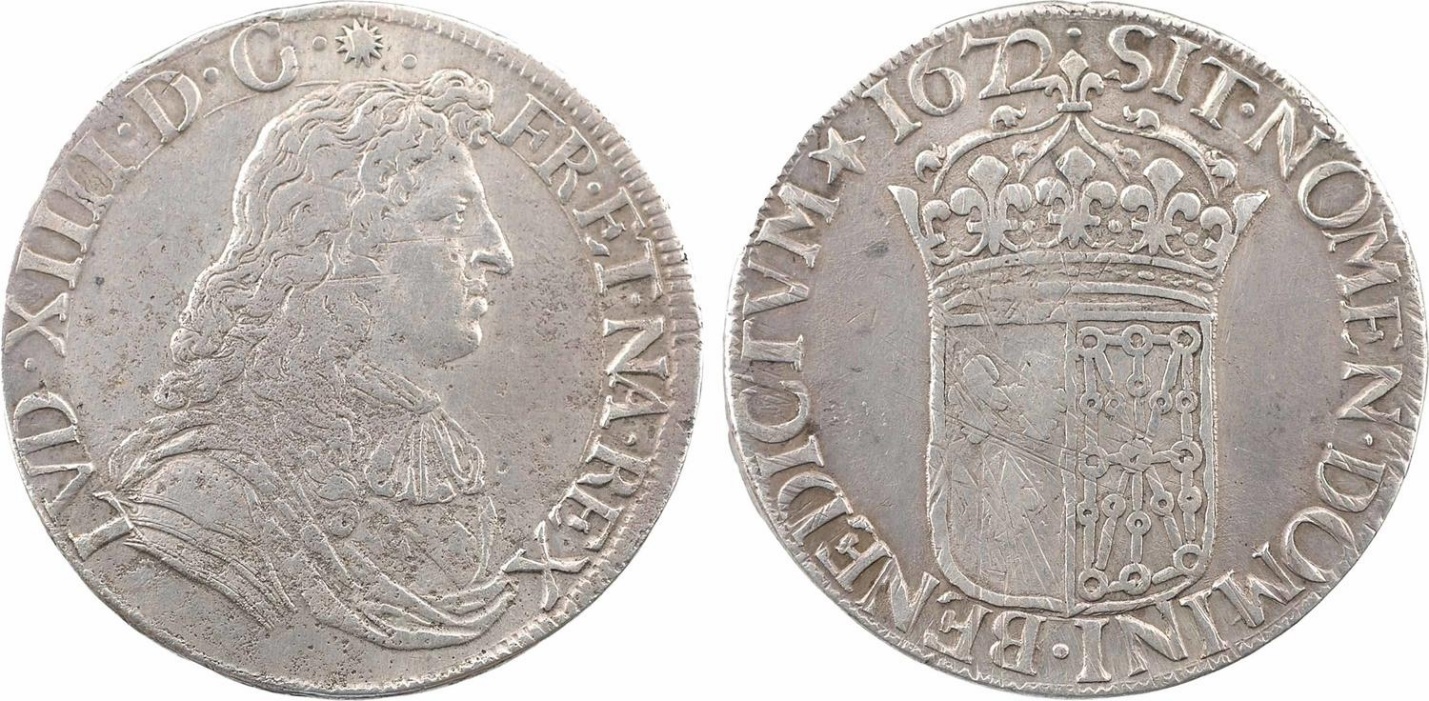
Shield sold by Inumis auction house on October 9, 2018 – 26.94 g 6 h 38.1mm – €9,277 – JD Collection – Described as 8th edition
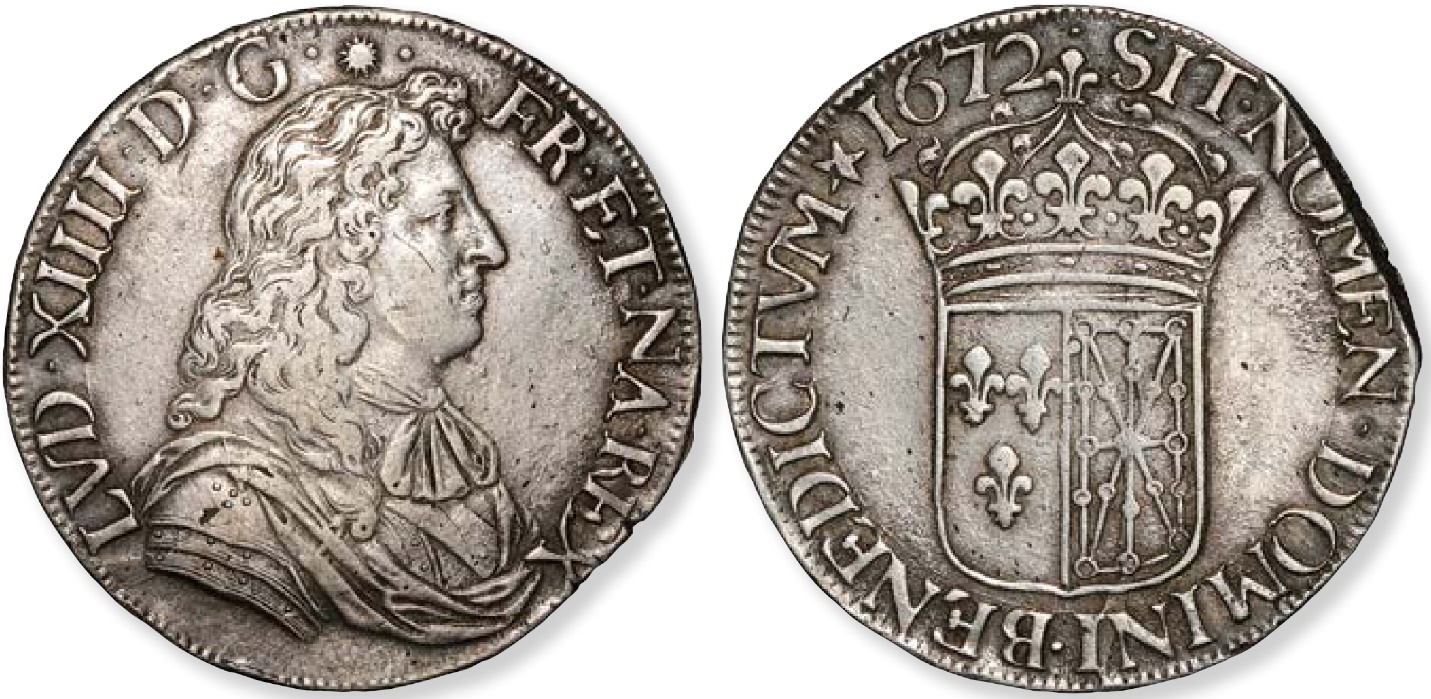
Shield sold by cgb auction house on March 9, 2021 – 27.17 g 6 h 39.0mm – €13,550 – Described as 9th edition
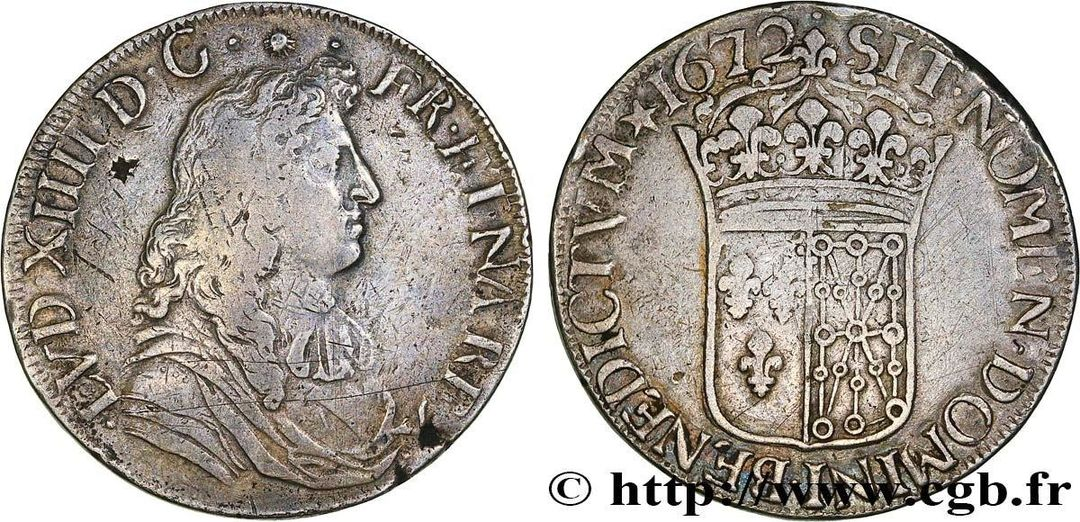
Shield offered by cgb auction house on June 15, 2021 – 27.07 g 6 h 38.0mm – €8,000 starting price, no bids – Claoue collection – Described as 4th edition
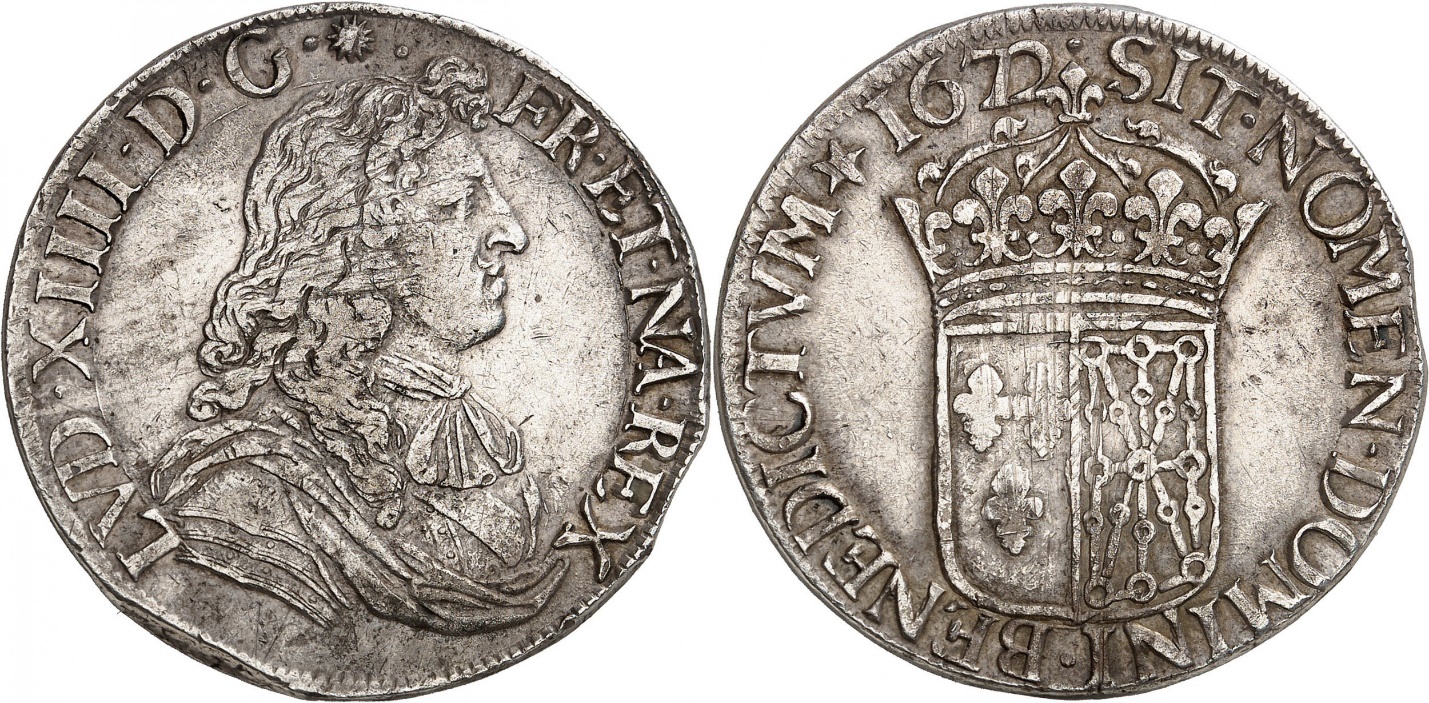
Shield offered by Burgan Numismatique auction house on November 12, 2021 – 26.98g – €12,000 – Jean Vinchon 1977 sale – Montalent Collection – Described as 1st edition
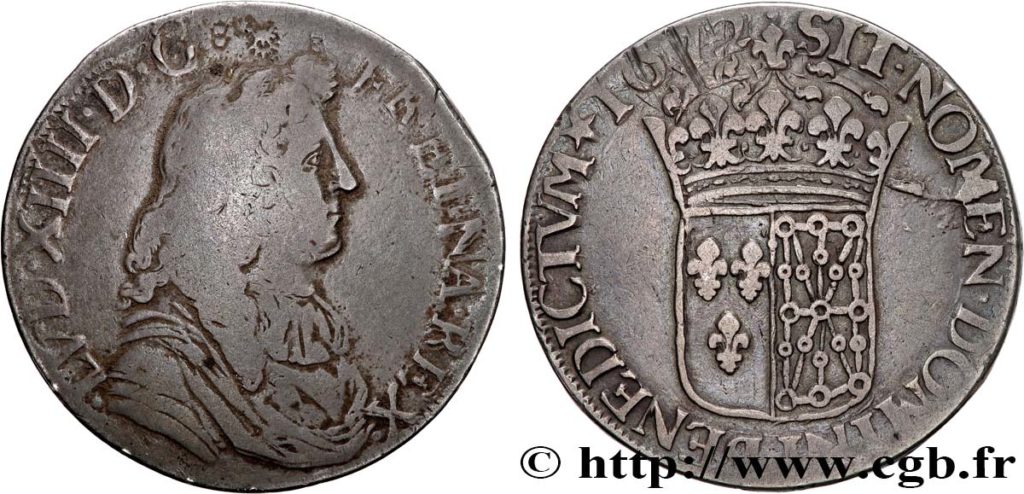
Shield offered by CGB auction house on September 6, 2022 – 26.82gr – €2500 – No buyer – Galerie Numismatique Drouot sale October 26, 1979 – Charlet Collection – Described as 2nd copy
As you can see, you need to have a full pocket if you want to acquire one of these specimens. The last two years have been very beneficial for auction house closing prices (I mean for sellers of course) and as a result, in 2021 alone, three specimens were presented for sale.
However, in addition to these six issues, Christian Charlet also presents the other three issues in his various works. Unfortunately, I have not been able to find any of these works and the seventh issue is missing from this entry. Here is a collection between the first and sixth issues (the arrows indicate the chronological order of the coinage, A being the first, F the last):
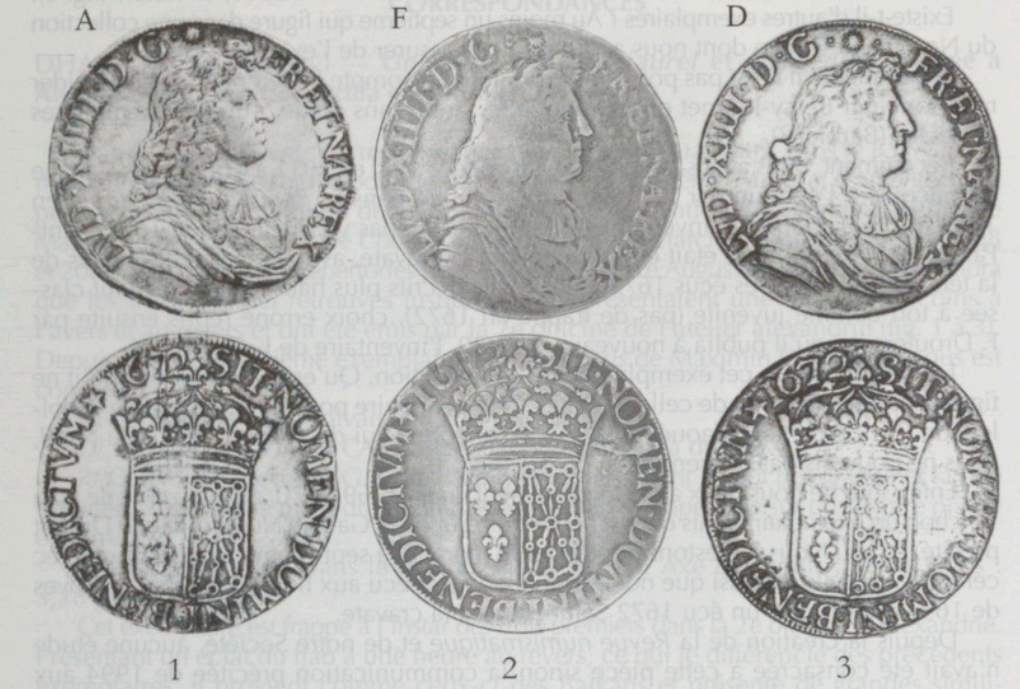
A look at the work of Christian Charlet – First, second and third issues
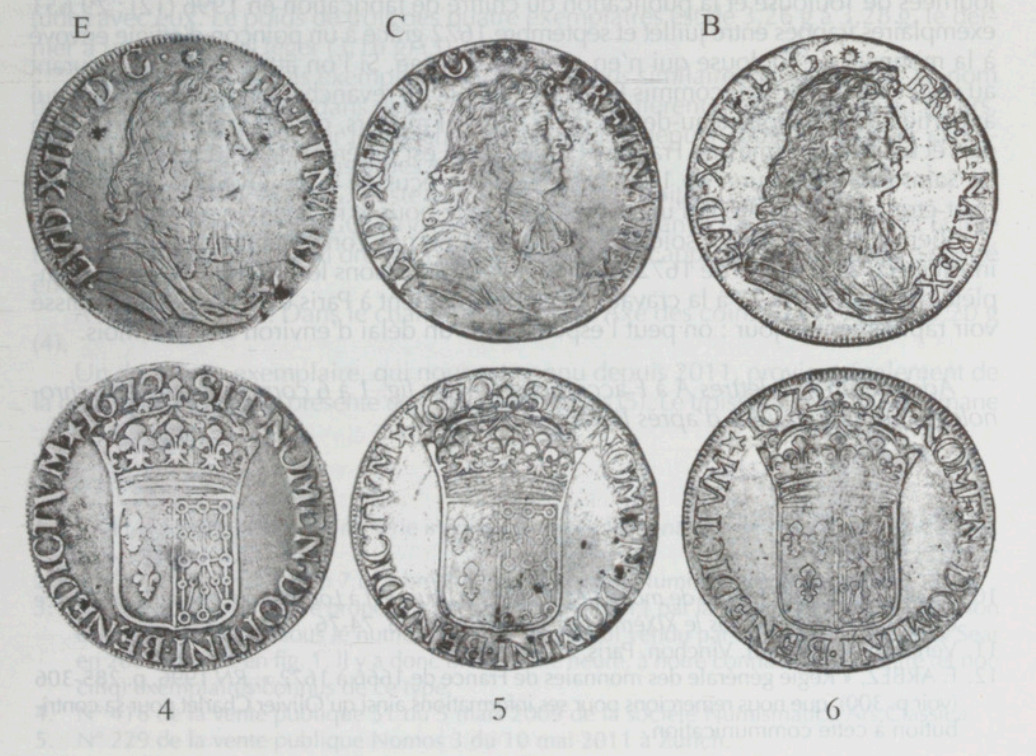
A look at the work of Christian Charlet – Fourth, fifth and sixth issues
Before we finish, we need to talk about the appearance of the reverse of the coin. The star that appears between the text and the year is the hallmark of the mintmaster Francois Le Noir. The image of the sun that appears on the obverse should be the hallmark of the engraver, but today, and despite the research of Armand Clairand and Christian Charlet, the name of this engraver is unknown.
The coins of 1672 have another special feature on the reverse, which is the coat of arms of the Kingdom of Navarre. This coat of arms, for the first (and last) time in the history of the Donapaleu Mint, features chains instead of the usual carbuncle.
According to Christian Charlet, this would seem to indicate that the punches and dies on the back were the work of a local engraver from Donapaleu. In my opinion, however, this shows the exact opposite. The locals were clear that the original Navarrese coat of arms was that of the carbuncle, as they had represented it throughout the three hundred years of the mint's history. Now, however, an unknown foreign engraver, perhaps Jean Baptiste Dufour, took the long-standing story of the chains of Navas de Tolosa as a basis for his conclusions and concluded that the true Navarrese coat of arms was that of the chains. The same thing happened in the copies produced at the Pamplona mint during the 16th and 17th centuries.
The engravers of Pau always kept the image of the carbuncle on the plate showing the coat of arms of Bearn, until they were finally able to engrave it in 1709. In fact, the coat of arms of Bearn at this time included that of Navarre.
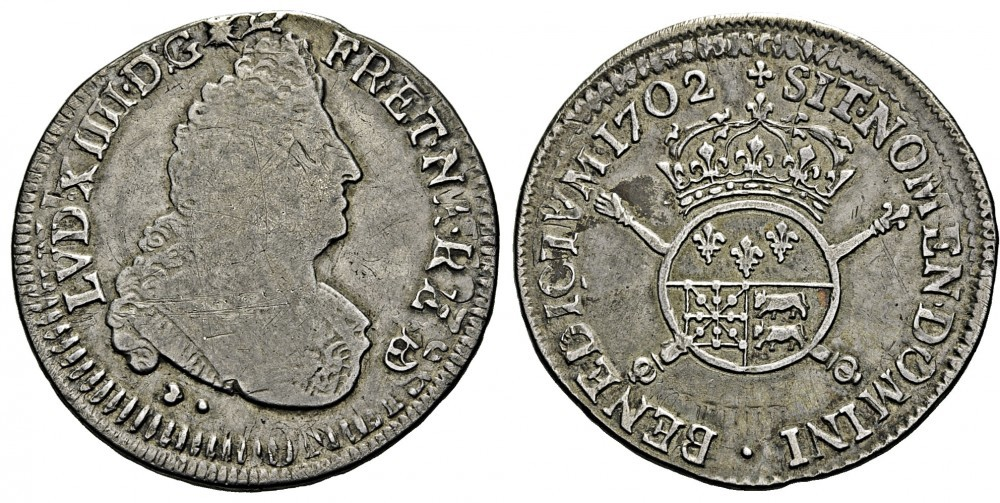
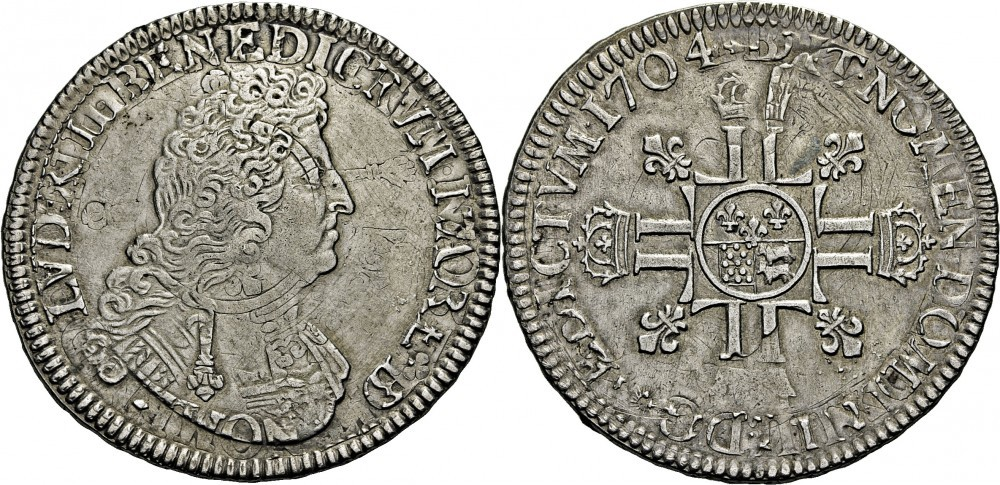
In the Pau mint, some of the last coins showing the coat of arms of Bearn. On the Pau coins, the Navarrese coat of arms always reflected the image of the carbuncle – 1702 and 1704 – In the second case, a reformed coin, engraved on an earlier first coin
From the 18th century onwards, on coins minted by the French mints, which were based on images by Parisian engravers, the coat of arms of Navarre was represented once and for all by chains.
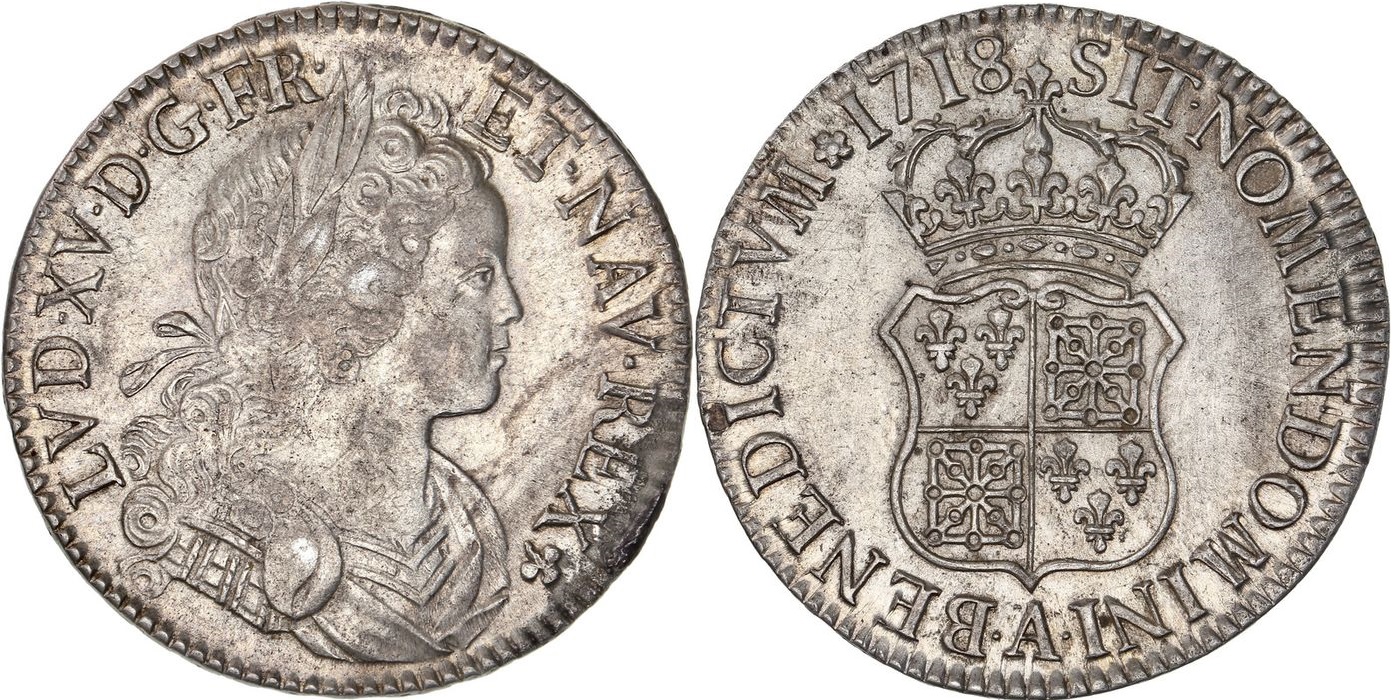
Ecu de Navarre or Shield of Navarre of Louis XV – 1718 – 38mm, 24.65gr – Paris Mint – Engraver George Röettiers – Collection from Monaco
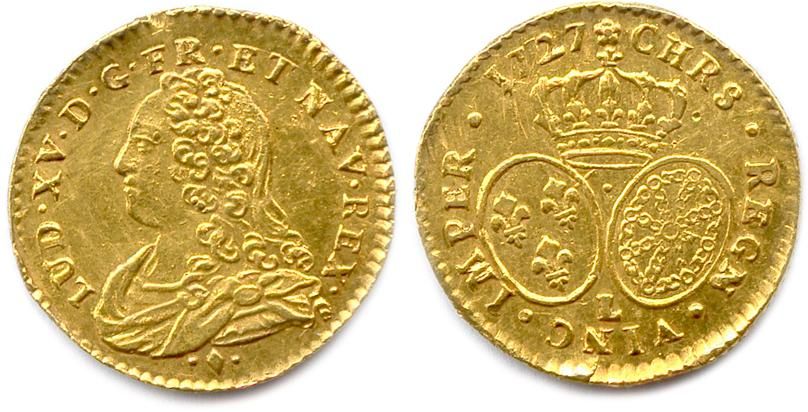
Gold half Louis of Louis XV – 1727 – 4.08gr – Bayonne Mint – Rose, Philippe I Ninon engraver – Rhombus, Jean Lacroix mintmaster
Bibliography:
Bulletin Numismatique 205 – Février 2021 – CGB.fr – UN NEUVIÈME ET BEL EXEMPLAIRE DE L'ÉCU DE LOUIS XIV, DIT «À LA CRAVATE», FRAPPÉ À SAINT-PALAIS EN 1672 – Christian Charlet – link
Les monnaies béarnais de Louis XIV (II) – Christian Charlet – link
Nouvelle Vente sur Offres de monnaies, médailles, jetons – iNumis 43 – Inumis auction house, Christian Charlet -2018 – link
Une utilization à Saint-Palais, en 1672, d'un poinçon d'effigie destiné à la Monnaie de Toulouse? – Christian Charlet, BSFN June 1994 – link
The rare and unusual «écu de Navarre à la cravate» struck at Saint-Palais in 1672, BSFN, avril 2013, p. 80-82 – Christian Charlet, Emmanuel Henry – link
Deux nouveaux exemplaires de «l'écu de Navarre à la cravate», frappé à Saint-Palais en 1672, BSFN, février 2014, p. 58-61 – Christian Charlet, Emmanuel Henry
Régie générale des monnaies de France from 1666 to 1672 – Fernand Arbez – 1994 – link
JEAN WARIN – Wikipedia – link
All personal data collected on this blog will only be used to disseminate the contents of this blog. Personal data will never be transferred or sold to third parties. You can unsubscribe at any time by clicking on the link in the footer of our emails.

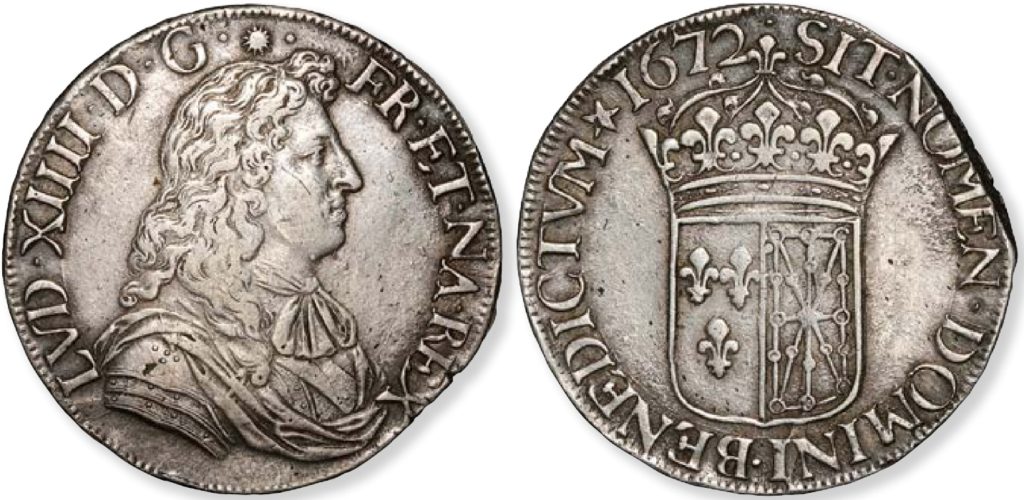
Pingback: The Last Nine Issues of Donapaleu • ZUZEU
Good entry!! Great pieces!! Much history. El Reino de los Basques, symbolized in the coins.
He has read several times that the Navarre chains reflect an ancient Basque symbol, an 8-pointed star. Hence the shape of the chains. Do you know if that's the case?
Greetings.
Hello Robert!
Well, they are actually more knowledgeable about heraldry than I am. I have no knowledge about the Vascones and the eight-pointed star. Several experts say that the chains of the current coat of arms of Navarre were previously a carbuncle. This transformation took place during the 16th and 17th centuries, although there are already the first references in the 15th century. Sancho VI the Wise is said to have begun using the carbuncle coat of arms and, as is known, for many centuries it was only the coat of arms of the royal house of Navarre... until later, during the modern era, it became the symbol of the territory. Going back from there to the Vascones... at least for me, it is difficult.